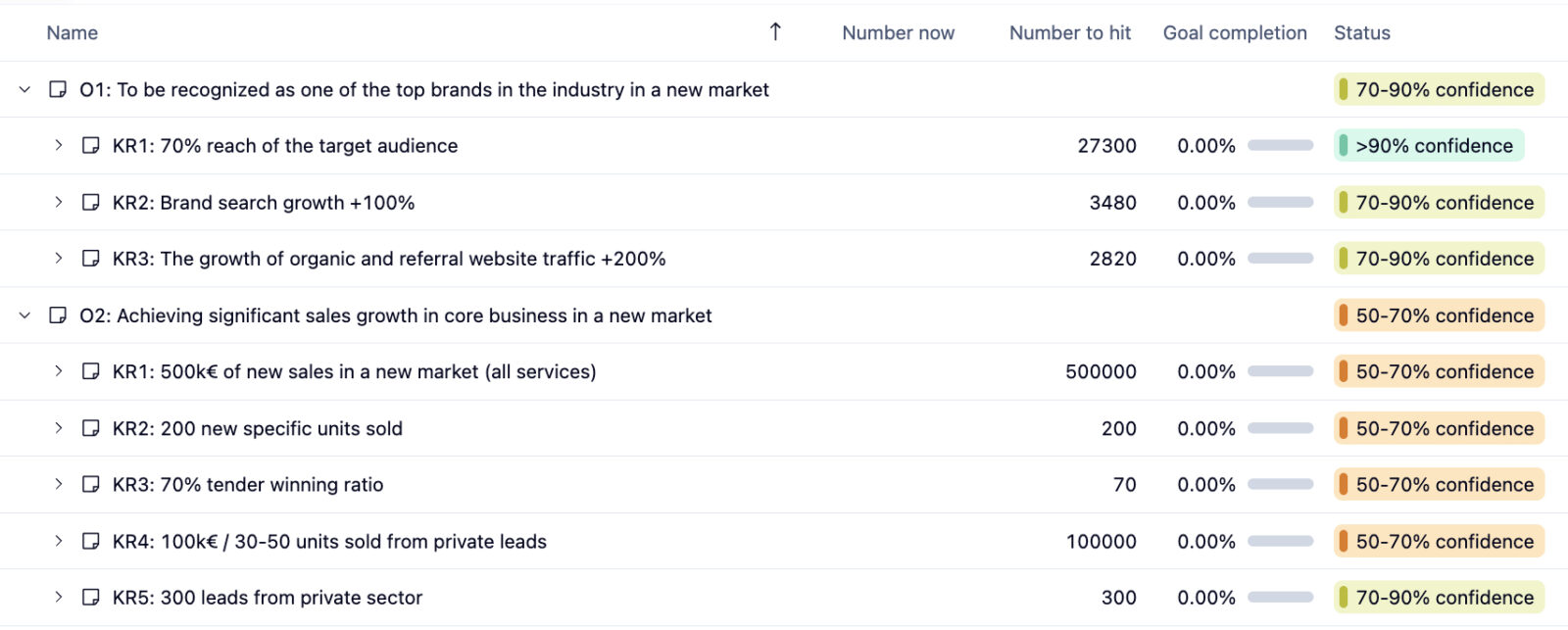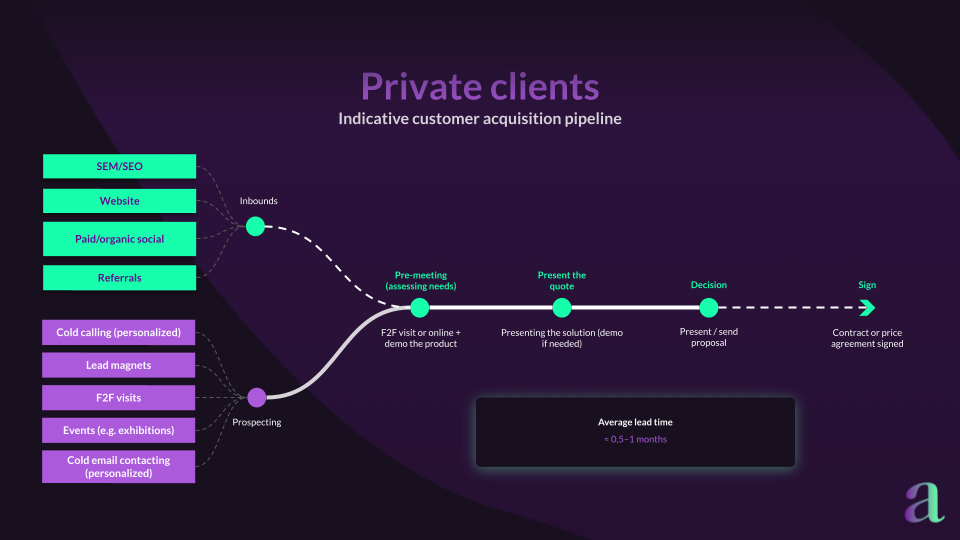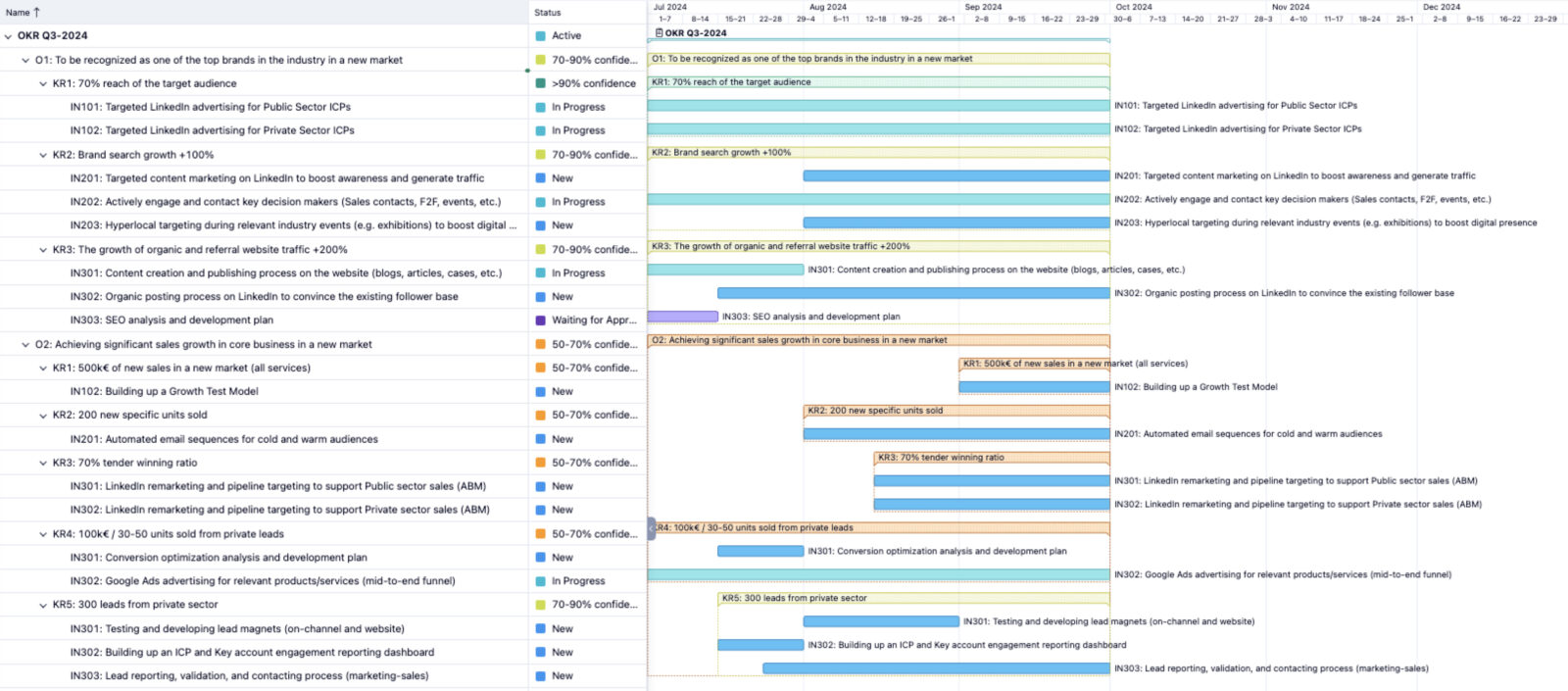Have you ever wondered if your company’s marketing resources are focused in an ideal manner? You’re not alone. Many companies struggle to determine where to focus their marketing efforts to maximize outcomes. A tactical marketing plan is a crucial part of optimizing a company’s budget to meet its full potential against critical business objectives.
We want to share an example case of tactical digital marketing planning and how it has been implemented for an international B2B growth company. In this post, we will walk you through the required steps in an efficient marketing planning process. At the end, you’ll find an example of a tactical marketing plan and how you could support your own planning process utilizing the Tactical Marketing Planning Turnkey Service concept.
1. Start by determining the needs
The first step in crafting a tactical digital marketing plan is to identify your company’s fundamental needs clearly. Begin by conducting a thorough needs assessment to understand the specific areas where marketing can drive the most value. Ask yourself, “Why are we starting this process in the first place?” By understanding the precise needs, you can tailor your marketing plan to address the most critical gaps and opportunities.
For instance, your company may be aiming to expand into new markets, launch a new product or line of business, support and gain general awareness within the desired target audiences, or achieve a thought-leadership position in your industry. By pinpointing these needs early, you ensure that every subsequent step in your marketing plan is aligned with achieving these strategic goals.
“Despite our four decades of success driven by technological innovation, we realized that to maintain our leadership and expand in the competitive market, a strategic marketing approach was essential. Aboad stepped in at a crucial time when we were struggling to bridge the gap between our high aspirations and practical execution.”
– Client’s Digital Marketing Manager
2. Assess history and current situation
Next, evaluate the historical performance of your marketing initiatives alongside the current market landscape. This involves looking at past campaign data, sales figures, and customer feedback. Identify what has worked well and what hasn’t, and understand why certain strategies succeeded or failed.
If you are planning efforts for a completely new line of business or another market area, you can look back at the data from other areas and make your assumptions based on those. Scalability is one of the key matters of a good marketing plan.
The Client Case:
Expanding to new markets, growing the business, and increasing market share in those areas were fundamental needs for kicking off the marketing planning process. This required a new, fresh way of seeing the marketing function as a key growth driver inside the organization.
3. Set the goals and objectives (OKR)
Once you have a clear understanding of your needs and current situation, it’s time to set your objectives and key performance indicators using the OKR (Objectives and Key Results) framework. Objectives should be ambitious yet achievable and aligned with your overall business goals. Key Results should be specific, measurable outcomes that track progress toward achieving each objective. We advise planning the OKRs either quarterly or every half-year since that way, it’s easier to follow the progress and make required changes in the process, if necessary.
For example, if your objective is to increase market share, your key results might include metrics like increasing website traffic by 30%, generating 50 new qualified leads per month, and achieving a conversion rate of 10%. By setting clear OKRs, you provide your team with a focused direction and measurable targets for which to aim.

The Client Case:
At the beginning of the planning process, we determined two major objectives:
1. To be recognized as one of the top brands in the industry in a new market, and
2. To achieve significant sales growth in core business in a new market.
The key metrics were refined to match these key business goals based on historical data and sales objectives.
4. Clarify target audiences (ICP) and main content themes
Identifying and understanding your Ideal Customer Profiles (ICP) is crucial for effective marketing. ICPs represent the types of customers who would benefit the most from your product or service and are most likely to convert–and who hold the most potential for your business. B2B companies should develop detailed profiles of potential customer organizations and identify key decision-makers inside the company.
When determining the key decision makers, examine the buyer personas more deeply: not only who they are or what their job title is, but also what critical issues and “jobs-to-be-done” your product or service can solve for them. In a nutshell, you need to ask: “How can we make their life easier?”
Based on your ideal customer company profile, you can either base your marketing on a targeted ICP level, but if you’re able to narrow the audience down to a list of specific companies, that allows you to implement ABM (account-based marketing) tactics. Some companies can even segment their audiences utilizing both ways: targeting a wider ICP audience, from where they can hand-pick the most potential organizations to implement accurately targeted ABM efforts.
Alongside clarifying your target audiences, you need to define your main content themes. These themes should address the needs and interests of your ICPs, positioning your company as a thought leader and problem solver in your industry. By aligning your content with your audience’s interests, you can attract and engage the right prospects and, most importantly: clarify your unique selling points and competitive edge compared to your competitors.
The Client Case:
The company’s target audiences included multiple segments that could be divided into two larger groups: public and private organizations. Each of these two audiences had its own ICPs based on the decision-making process in the specific segment. Additionally, it was identified that the purchase process, core issues, and “jobs-to-be-done” were different between these segments—this set the requirements for defining the content themes to exactly match each audience’s key interests.
Plan audiences like a pro: Ideal Customer Profile (ICP) in B2B Digital Marketing >
5. Map the customer acquisition process
Mapping out your customer acquisition process involves detailing each step a prospect takes during the purchasing process. It’s essential that marketing is aligned with the sales process to be able to fully understand and support each step accordingly. Matching the tactical marketing plan with the sales process enables you to measure, analyze, recognize, and optimize possible bottlenecks and weak spots in each phase of the journey.
An additional benefit is that when determining the process, sales can review and understand the customer acquisition process more thoroughly. It often clarifies the steps in the process itself but also widens the understanding of the marketing benefits before and during the process. This way, sales and marketing functions are closer to each other from the beginning, and possible miscommunication or misunderstanding is avoided effectively.

The Client Case:
As noted before, the two different segments were found to behave totally differently in their sales and purchase processes. Therefore, it was crucial to understand the differences between the public and the private sector so marketing actions could be aligned to fully support the customer acquisition process in each of its steps. Also, we could recognize the differences in the expected length of the sales process, which allowed us to figure out where the quickest wins were expected.
6. Plan the initiatives based on goals and key metrics (OKR)
With your objectives, key results, and customer acquisition process mapped out, you can now plan specific marketing initiatives. Each initiative should be designed to achieve one or more of your key results. Note that at this stage, budgets shall not limit the planning, but it should be the marketer’s best possible projection of how all of these key results and objectives will be accomplished.
The simple question to follow when planning initiatives is: “What do we need to do to achieve these goals?” By planning initiatives that are directly tied to your OKR, you can maintain a clear line of sight between your marketing activities and your business goals. Initiatives can widely include actions such as paid and organic marketing efforts, digital and F2F actions, and sales activities. The most important thing is that each initiative drives the key metric and the main objective that it’s planned for.

The Client Case:
The company’s marketing initiatives included a wide range of activities, mixing sales and marketing efforts, digital and F2F measures, and targeted ICP and ABM advertising. As the sales processes are knowingly long, the key driver was to create as many relevant, well-targeted contact points as possible to cover each step of the customer journey and generate long-term sales possibilities.
Dive deeper into the topic: How to Develop a Marketing Plan Utilizing the OKR Model >
7. Come up with an action plan and initiative budgets
Following the initiatives, develop a detailed action plan that outlines the specific steps needed to execute each initiative. This plan should include timelines, responsibilities, and required resources. After calculating the resource estimation for each initiative (work and media budgets), start drafting the overall budget based on your planned activities.
Then, when you compare the budgeted actions and your available resources, you can start scheduling and prioritizing initiatives. Not all activities should be carried out immediately, but lay your actions in prioritized order during your planning period (quarterly or half-year). If you need to restrict your planned activities based on the available budget, you would also need to communicate how it will affect the expected results (e.g. “If we don’t do this action, the results will expectedly land at about 50% of the objective.”) The key principle is, that if you save on your actions, you cut your objectives at the same time–this shall not be an issue, but a clear communication to manage expectations between the marketing, sales, and management teams.
When you get approval for your action plan and budget, it’s your responsibility to deliver the promised results. Therefore, be really thorough when assigning and managing initiatives and analyze and optimize their performance regularly. Make sure that every task is delivered at its best possible quality, and stay on schedule and budget to avoid negative surprises.

The Client Case:
After planning and scheduling the initiatives, the OKR worked as a basis for the tactical marketing plan. By determining actions, channels, and estimated budgets, we calculated the overall marketing budget for the desired period. Since the plan was accepted as it was, the marketing function committed to delivering every action in its scheduled order to achieve the desired and set objectives.
Learn more: High-Quality Project Management is a Crucial Part of Successful Marketing >
Example of a tactical marketing plan
The finalized marketing plan for this international B2B growth company included:
- Goals & Objectives (OKR)
- Target Audiences & Content Themes
- Customer Acquisition Process
- Tactical Marketing Plan (based on OKR’s initiatives)
- Action Plan & Indicative Budgeting
The audiences were divided into two main segments: the public sector and the private sector. Key decision-makers, decision-making committees (influencers), and unique sales processes were determined for each segment separately.
The main objectives were found as:
O1: To be recognized as one of the top brands in the industry in a new market
O2: Achieving significant sales growth in core business in a new market
Followed by the key performance indicators:
KR1.1: 70% reach of the target audience
KR1.2: Brand search growth +100%
KR1.3: The growth of organic and referral website traffic +200%
KR2.1: 500k€ of new sales in a new market (all services)
KR2.2: 200 new specific units sold
KR2.3: 70% tender winning ratio
KR2.4: 100k€ / 30-50 units sold from private leads
KR2.5: 300 leads from private sector
Next, the initiatives worked as a basis for the tactical plan divided by the target audience stage of the customer acquisition process:

Since the initiatives and budget were approved, all of the above were used to prioritize and form a solid action plan based on the tactical marketing concept using the Gantt chart framework.
“Working with Aboad to develop our tactical marketing plan has been nothing short of revolutionary. Aboad’s approach was methodical and insightful. They helped us distill our strategic objectives into clear, measurable marketing targets. This not only made the goals more tangible but also simplified the process of identifying the specific actions needed to achieve these goals. Their expertise was instrumental in translating these actions into a structured list that was directly linked to our strategic aims, ensuring every task had a clear purpose and measurable impact.
Moreover, Aboad’s involvement extended beyond mere planning; they were pivotal in aligning our marketing efforts with the sales department, enhancing synergy and understanding between the two. This integration has fostered a collaborative environment where marketing and sales share common goals—goals that everyone believes in and is committed to achieving.
Perhaps one of Aboad’s most significant contributions was their ability to help us develop a comprehensive budget proposal that reflected our new marketing strategies. This budget was not only functional but also transparent, making it easier to communicate our needs and plans to the board with confidence. For the first time in our history, we had a tactical plan that was both ambitious and realistic, strongly linked to our strategic vision and perceived as achievable by our team.”
– Client’s Digital Marketing Manager
Tactical Marketing Planning Turnkey Service
Do you want to improve your marketing but lack tools or resources or don’t know how to? If you need assistance forming your marketing principles, determining objectives, or aligning actions with your key business goals, we’ve got you covered: Alongside our comprehensive MaaS services, we offer a Tactical Marketing Planning Turnkey Service as an individual concept for growth-seeking companies.
“Aboad’s role was crucial in helping us see the value of a structured marketing plan and in implementing it successfully. Their guidance has undoubtedly set us on a new path of strategic communication and marketing, essential for today’s business environment.”
The Tactical Marketing Planning Turnkey Service concept helps you refine your marketing efforts to achieve peak performance with well-planned, actionable, and measurable efforts driving directly toward your primary business objectives. As a result, you will have:
✓ Clear objectives for marketing
✓ Tactical plan/guidelines (channels, etc.)
✓ Hot takes and best practices from industry-wide knowledge
The service can be delivered as an individual project or easily integrated into continuous cooperation in a desired role based on planned actions and available resources–from strategic-level mentoring to day-to-day operative tactical marketing.
The service includes:
✓ Pre-meeting call (30-min)
• Understanding the current situation and background and achieving access to necessary resources
✓ Preparing the meeting
• Auditing previous campaigns
• Making suggestions based on the current situation, knowledge, and long-term expertise from the strategic and tactical aspects of marketing
✓ 3-hour workshop together consisting of at least the following topics:
• Customer acquisition plan
• Targeting criteria: countries, companies, decision-makers (ICP, Ideal Customer Profile)
• Marketing channel consultation
• Sales-oriented marketing pipeline and customer acquisition process
✓ Tactical marketing plan debrief (30-60 min)
• Action plan and initiative budgets
• Chosen frameworks for effective implementation
• Key performance indicators, how to measure and report the success
Estimated go-through time: 3 weeks
Price: starting from 1,890.00€ (excl. VAT)
After the project, your company will gain an advantage by staying ahead of the competition, adapting to new opportunities, and consistently driving growth through effective business-driven marketing. With a functional tactical marketing plan, you can ensure your marketing performs at its best, delivering measurable results and driving sustainable growth.
If you have any questions, don’t hesitate to contact!
Book a brief 15-minute meeting >
